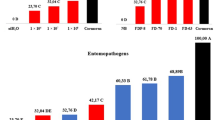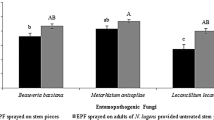Abstract
Termites are an important component of savannah ecosystems throughout Africa. Despite their importance in the ecosystem, they can be serious pests of structures, houses, rangelands, tropical forestry, and agriculture. For many decades, chemical insecticides have remained popular for termite management worldwide. However, with the growing environmental concerns over pesticides, biological control using entomopathogenic fungi such as Metarhizium anisopliae (Metschnikoff) Sorokin has become an often-considered alternative. Metarhizium anisopliae is an ubiquitous, naturally occurring pathogen, which has been reported infecting over 200 insect species; therefore, there is concern that use of M. anisopliae may affect non-target organisms. The effects of M. anisopliae isolate ICIPE 30 were experimentally tested on the ants which associate with Odontotermes spp. termite mounds. Laboratory bioassays were carried out to assess the effects of direct exposure to M. anisopliae on Crematogaster mimosae and Camponotus spp. In addition, ant diversity was monitored over 18 months from termite mounds treated with M. anisopliae in situ near the Mpala Research Centre in Laikipia District of central Kenya. Results obtained revealed no effects of direct exposure to M. anisopliae isolate ICIPE 30 on the mortality of C. mimosae (F1 = 7.29, P = 0.0072) or Camponotus spp. (F1 = 13.01, P = 0.0004) in the laboratory. No significant difference in Shannon indices of ant diversity from treated and untreated mounds (F1 = 0.016, P = 0.8989) was found. It is evident that M. anisopliae has no negative effects on ants that are associated with Odontotermes spp. termites.
Similar content being viewed by others
References
Burgerjon A. (1956) Pulvérisation de poudrage au laboratoire par des preparations pathogens insecticides. Annales INRA Epiphyties 4, 677–688.
Cornelius M. L., Grace J. K., Ford P. W. and Davidson B. S. (1995) Toxicity and repellency of semiochemicals extracted from a dolichoderine ant (Hymenoptera: Formicidae) to the Formosan subterranean termite (Isoptera: Rhinotermitidae). Environmental Entomology 24, 1263–1269.
Culliney T. W. and Grace J. K. (2000) Prospects for the biological control of subterranean termites (Isoptera: Rhinotermitidae), with special reference to Coptotermes formosanus. Bulletin of Entomological Research 90, 9–21.
Dangerfield J. M., McCarthy T. S. and Ellery W. N. (1998) The mound-building termite Macrotermes michaelseni as an ecosystem engineer. Journal of Tropical Ecology 14, 507–520.
Darlington J. P. E. C. and Bagine R. K. N. (1999) Large termite nests in a moundfield on the Embakasi Plain, Kenya (Isoptera: Termitidae). Sociobiology 33, 215–225.
Edwards R. and Mill A. E. (1986) Termites in Buildings: Their Biology and Control. Rentokil Limited, East Grinstead, United Kingdom. 261 pp.
Ekesi S., Maniania N. K., Ampong-Nyarko K. and Onu I. (1999) Effect of intercropping cowpea with maize on the performance of Metarhizium anisopliae against Megalurothrips sjostedti (Thysanoptera: Thripidae) and predators. Environmental Entomology 28, 1154–1161. doi: https://doi.org/10.1093/ee/28.6.1154.
Goettel M. S. and Inglis G. D. (1997) Chapter V-3 — Fungi: Hyphomycetes, pp. 213–249. In Manual of Techniques in Insect Pathology (edited by L. A. Lacey). Academic Press, San Diego.
Gonçalves T. T., Reis R., DeSouza O. and Ribeiro S. P. (2005) Predation and interference competition between ants (Hymenoptera: Formicidae) and arboreal termites (Isoptera: Termitidae). Sociobiology 46, 409–419.
Gotelli N. J. and Entsminger G. L. (2005) Ecosim: Null Models Software for Ecology. Version 7.0. Acquired Intelligence Inc. & Kesey-Bear.
Gotwald W. H. (1995) Army Ants: The Biology of Social Predation. Cornell University Press, Ithaca. 302 pp.
Hepburn H. R. and Radloff S. E. (1998) Honeybees of Africa. Springer, Berlin, Germany. 370 pp.
Hölldobler B. and Wilson E. O. (1990) The Ants. Harvard University Press, Massachussets. 742 pp.
Howe F. H. and Westley L. C. (1988) Ecological Relationships of Plants and Animals. Oxford University Press, Oxford. 288 pp.
Jones D. T. and Eggleton P. (2000) Sampling termite assemblages in tropical forests: testing a rapid biodiversity assessment protocol. Journal of Applied Ecology 37, 191–203. doi: https://doi.org/10.1046/j.1365-2664.2000.00464.x.
Kooyman C. and Onck R. F. M. (1987) The interactions between termite activity, agricultural practices and soil characteristics in Kisii District, Kenya. Agricultural University Wageningen Papers No. 87-3. Wageningen Agricultural University, The Netherlands. 120 pp.
Mailu A. M., Gitonga W. and Fugoh P. O. (1995) Proceedings of the Second Regional Workshop on Termite Research and Control, KARI, Nairobi, Kenya, pp. 49–51.
Maniania N. K., Ekesi S. and Songa J. M. (2002) Managing termites in maize with entomopathogenic fungus Metarhizium anisopliae. International Journal of Tropical Insect Science 22, 41–46. doi: https://doi.org/10.1017/S1742758400015046.
Maniania N. K., Sithanantham S., Ekesi S., Ampong-Nyarko K., Baumgärtner J., Löhr B. and Matoka C. M. (2003) A field trial of the entomogenous fungus Metarhizium anisopliae for control of onion thrips. Thrips tabaci. Crop Protection 22, 553–559.
Matteson P. C. (1992) A review of field studies of the environmental impacts of locust/grasshopper control programmes in Africa, pp. 347–355. In Biological Control of Locusts and Grasshoppers (edited by C. J. Lomer and C. Prior). CAB International, Wallingford, Oxon, UK. ISBN 0 85198 779 6.
Milner R. J. (2000) Current status of Metarhizium as a mycoinsecticide in Australia. Biocontrol News and Information 21, 47N-50N.
Mitchell J. D. (2002) Termites as pests of crops, forestry, rangeland and structures in Southern Africa and their control. Sociobiology 40, 47–69.
Mullié W. C. and Keith J. O. (1993) The effects of aerially applied fenitrothion and chlorpyrifos on birds in the savannah of northern Senegal. Journal of Applied Ecology 30, 536–550. doi: https://doi.org/10.2307/2404193.
Paine R. T. (1969) A note on trophic complexity and community stability. The American Naturalist 103, 91–93.
Peveling R., Rasolomanana H., Raholijaona Rakotomianina L., Ravoninjatovo A., Randimbison L., Rakotondravelo M., Raveloson A., Rakotoarivony H., Bezaka S., Ranaivoson N. and Rafanomezantsoa J.-J. (2001) Effets des traitements aériens de fipronil et de deltamethrine en couverture totale sur la chaîne alimentaire, pp. 525–572. In Lutte Antiacridienne à Madagascar — Tome III — Ecotoxicologie (edited by W. Zehrer). DPV/GTZ, Ministère de l’Agriculture, Antananarivo, Madagascar.
Rath A. C. (2000) The use of entomopathogenic fungi for control of termites. Biocontrol Science and Technology 10, 563–581.
Rath A. C., Worledge D., Koen T. B. and Rowe B. A. (1995) Long-term field efficacy of the entomogenous fungus Metarhizium anisopliae against the subterranean scarab, Adoryphorus couloni. Biocontrol Science and Technology 5, 439–452.
Sekamatte M. B. (2001) Options for integrated management of termites (Isoptera: Termitidae) in smallholder maize-based cropping systems in Uganda. PhD thesis, Makerere University, Uganda.
Vivian-Smith G. (1997) Microtopographic heterogeneity and floristic diversity in experimental wetland communities. Journal of Ecology 85, 71–82.
Vosseler J. (1905) Die Ostafrikanische Treiberameise (Siafu). Pflanzer 1, 289–302.
Wightman J. A. (1991) Soil insect problem in African groundnut crops, pp. 171–176. In Advances in Management and Conservation of Soil Fauna (edited by G. K. Veeresh, D. Rajagopal and C. A. Viraktamath). Oxford & IBH Publishing Co. Pvt. Ltd., New Delhi/Bombay/Calcutta.
Wood T. G., Bednarzik M. and Aden H. (1987) Damage to crops by Microtermes najdensis (Isoptera, Macrotermitinae) in irrigated semi-desert areas of the Red Sea coast. 1. The Tihama region of the Yemen Arab Republic. Tropical Pest Management 33, 142–150. doi:https://doi.org/10.1080/09670878709371135.
Wood T. J. and Pearce M. J. (1991) Termites in Africa: the environmental impact of control measures and damage to crops, trees, rangeland and rural buildings. Sociobiology 19, 221–234.
Zimmerman G. (2007) Review on safety of the entomopathogenic fungus Metarhizium anisopliae. Biocontrol Science and Technology 17, 879–920. doi: https://doi.org/10.1080/09583150701593963.
Author information
Authors and Affiliations
Corresponding author
Rights and permissions
About this article
Cite this article
Abonyo, E.A., Maniania, N.K., Warui, C.M. et al. Effects of entomopathogenic fungus Metarhizium anisopliae on non-target ants associated with Odontotermes spp. (Isoptera: Termitidae) termite mounds in Kenya. Int J Trop Insect Sci 36, 128–134 (2016). https://doi.org/10.1017/S1742758416000114
Accepted:
Published:
Issue Date:
DOI: https://doi.org/10.1017/S1742758416000114




